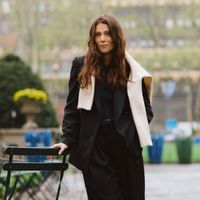Tag, You're It
One company is using clothing labels to help keep the fashion industry accountable—and garments accounted for.


Clothing tags. Those skin-scratching additions to our clothes that have rarely saved us from shrinking our favorite shirt. Those generic labels so overlooked that many are purposely designed to be conveniently ripped off. At least, until now. Natasha Franck, the founder and Chief Executive Officer of the software platform EON, saw an opportunity to use clothing labels as a way to add transparency and accountability to the style industry; a solution to help make fashion more sustainable using something that already exists. Her idea was to tag a garment with a unique digital ID in the form of a QR code, NFC tag, or other data carrier that, when scanned, gives consumers important knowledge about their item. Like information about the clothing’s fabrics, supply chain conditions, amount of water used to make the item, and point of sale.

In addition to historical and material information, the digital ID provides consumers with care instructions, repair guidance, and resale options tailored to that specific item, which could extend a product’s life or keep it from getting tossed into landfill. A big problem for the fashion industry, since it’s estimated that 21 billion pounds of textiles produced each year end up in the trash. “A digital ID delivers transparency about that product, where it came from, and what you should do next,” says Franck. That might mean a second or third life for a garment through buyback programs or recycling recommendations. “We need every product and material to be accounted for, so it can be stewarded and managed throughout its life cycle,” she says. “Digital ID is the core enabler of this next-gen world.”
Almost five years ago, sustainability-focused fashion designer Gabriela Hearst became EON’s first client when she saw digital ID’s potential to allow for more transparency and traceability for her eponymous clothing line. “It was essential for us to be able to tell the story of each piece of clothing to our clients,” says Hearst. “Even though I am passionate about the subject, it was hard to gather this information otherwise. We put so much effort into sourcing materials and ensuring they’re responsible when developing a collection. [Digital ID] can now allow people to learn about the fabric, the mill, and the factories behind each item and what they’re doing to ensure workers’ rights and safety.”
A digital ID delivers transparency about that product, where it came from, and what you should do next.
Since then, EON has continued to build a network of brands whose shoppers are able to unfurl a garment’s entire ecosystem in seconds. Among them: Chloé, Mulberry, and YOOX Net-a-Porter Group. “It’s becoming an understanding within the industry that [digital ID] is an obvious future,” says Franck. That became even clearer in March of last year, when the European Commission announced a policy proposal for the standardization of Digital Product Passports as part of their Circular Economy Action Plan. The proposal will require retailers to publish information on products’ environmental impacts and life cycle, intending to disrupt the destruction of unused goods.
But here in the U.S., without widespread policy change, it will be up to individual brands to decide whether they want to adopt the use of digital tags. Like most things, the whole is greater than the sum of its parts. But Franck is hopeful that more and more designers will be open to putting a (digital) label on it, adding: “It’s exciting to have it feel like digital ID is reaching a bit of a tipping point.” Now is the time for the fashion industry to accept the challenge of becoming more responsible—and to run with it.
High (Tech) Fashion


Get exclusive access to fashion and beauty trends, hot-off-the-press celebrity news, and more.

Sara Holzman is the Style Director at Marie Claire, where she has worked in various roles to ensure the brand's fashion content continues to inform, inspire, and shape the conversation around fashion's ever-evolving landscape. A Missouri School of Journalism graduate, she previously held fashion posts at Condé Nast’s Lucky and Self and covered style and travel for Equinox’s Furthermore blog. Over a decade in the industry, she’s guided shoots with top photographers and stylists from concept to cover. Based in NYC, Sara spends off-duty hours running, browsing the farmer's market, making a roast chicken, and hanging with her husband, dog, and cat. Find her on Instagram at @sarajonewyork.